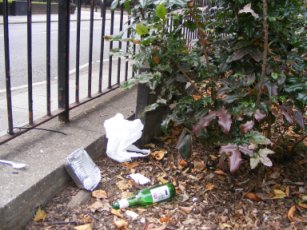| Additional
notes by Brian Firth. St. Leonard's Churchyard. I½ acres. Burial place of Richard Burbage (Elizabethan actor, d. 1619) and other members of the Burbage family. Also James Parkinson, who identified Parkinson's disease. (d. 1824) Burials ceased 1858. The paved west entry has some stones in the flanking walls. The rest of the ground is laid out as a park with no sign of its past, though it does have a memorial to civilian dead of WW2.There is a lot of tarmac, and a crude tumble-down cement garage in the middle, built on the site of the old mortuary. Altogether it is desperately unloved, although the roses in the flower beds appear to be well tended. There is part of a parish pump, and a whipping post and stocks. Clearly a popular meeting place for middle-aged men drinking lager. Why are these very sad alcoholics so fond of churchyards? A sense of sanctuary perhaps, or may be the church authorities are simply more compassionate than the people that run parks. Maintained as a public garden by the Shoreditch Vestry. It is, I believe, partly in Bethnal Green. (Holmes) |
|||
|
|
|
||
Old Burial-ground, Hackney Road. On the north of the road, near ½ acre. This has an ancient watch-house in it, which was subsequently used as a cholera hospital. In 1891 the Metropolitan Public Gardens Association laid it out as a public playground, and it is maintained by the Burial Board. |
|||

Horwood



The last gravestone
Holywell Mount Burial-ground.
The church was demolished in 1935; it was on the site of the present day 21 Curtain Rd. The plague ground is the open yard area accessed from 38 Scrutton Street; it may well have extended under nearby buildings. 1872 O.S. Shows a school on the site. The yard is now a car park for the surrounding small businesses.
In use as a burial ground for many centuries.
Behind St. James's Church,
Curtain Road, which occupies the site of a theatre of Shakespeare's
time. The ground is very old, and was much used at the time of plagues,
and many actors are buried there. There is only about ⅓ acre left,
the greater part having been used as the site for a parish room, and
this is a timber-yard approached from Holywell Row.

Horwood - open fields on
Rocque

Old print of Holywell
Plague Pit

The view today
St. Mary's Churchyard, Haggerston.
Church bombed during WW2.
This ground is now a tidy recreation area in the middle of a housing estate.
1⅓ acre. This is maintained by the Shoreditch Burial Board as a public garden, open during the summer. It was laid out by the Earl and Countess of Meath in 1881. (Holmes)

St Mary Haggerston
Photo courtesy of Martin Vidler
PItfield Rd. Built 1824-26. Churchyard only in use for around 25 years. Partly tarmacked for use of the adjacent school, partly laid out as a fairly bleak park.
1¼ acres. Also maintained by the Shoreditch Burial Board, and laid out by the Earl and Countess of Meath. (Holmes)



The view from the ground
of the delights of Hoxton
Geffrye Almshouse Burial-ground,
Not included on Holmes list. It is a strip at the north end of what is now the

Jewish Burial-ground, Hoxton Street.
Used 1707-1878 by Hambro Synagogue of Fenchurch St. Remains to West Ham where they were reinterred under what had been paths. There is no trace now. Under the Community College.
¼ acre. This belongs to the United Synagogue, and was used from 1700 till 1795. There is no grass, but many tombstones, and some one is sent four times a year to clear away the weeds, &c. It is not a tidy ground. (Holmes)
Gloucester Street Chapel Ground, Haggerston (Now Whiston Rd.)
The chapel was in existence from about 1812, when it was independent. From 1837 ownership changed possibly becoming an Anglican Chapel. Burials from as early as 1820, possibly earlier.
Intriguing evidence from Roger Harvey, who has looked into a family burial here. His research reveals that during the 1830s some bodies were placed in the vault for a few months before being interred in the burial ground. Might this be due to fear of body snatching?
the ground was lost c. 1859 when the gas works to the south was extended..
Built over - Gas Light and Coke Company's premises. (Holmes)

Greenwood's Map (1827)
showing Gloucester Chapel Black rectangle) and St. Mary's Haggerston

Site of Gloucester Chapel
Photo courtesy of Martin Vidler
Shoreditch Burial-ground, Hoxton
The workhouse ground. Opened 1774, not long after the opening of the workhouse. Other sources, and the 1872 O.S., suggest the building work mentioned by Holmes below took place in the 1860s. No trace of the burial ground on the 1872 map.
Buildings became a hospital (St. Leonard's) by the end of the 19th c. This was closed in 1948 but the workhouse buildings remain.
Burial ground under Ben Jonson Court .
Built over - Wing of the Workhouse built in 1884. (Holmes)
Burial-ground by the Goldsmiths' Almshouses
In Goldsmith's Row. The almshouses are shown on the O.S. of 1872 but had gone by the time Holmes wrote the note below in the 1890s. The burial ground was probably behind the almshouses where a garden is shown.
Now the site of the City Farm.
Built over - New block of Artisans' Dwellings west side of Goldsmith Row. (Holmes)
Small closed yard. Used for others as well as Aske’s inhabitants. . Not included on Holmes' list. Shown on 1872 OS, but not on Horwood. After the almshouse was replaced by the

Photo courtesy of
Robert Bard
Worship Street Baptist Chapel Ground.
Shown on OS of 1872 but gone
by 1894.
Remains removed to Brookwood.
In the early 19th
c. the eastern end of
Worship Street was known as Hog Lane.
Built over - London and North Western.
Goods Depot. (Holmes)

Horwood.

